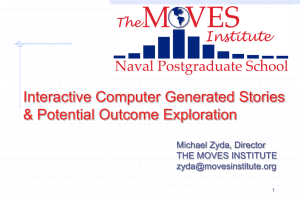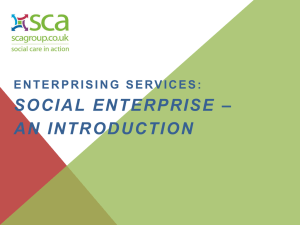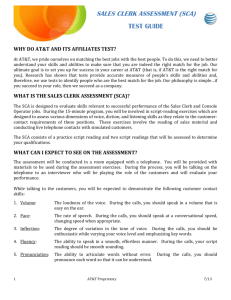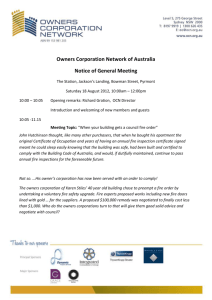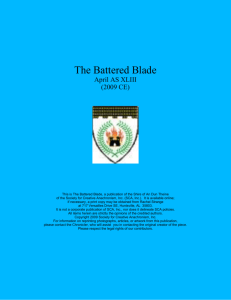MOVESStoriesOutcomesBoaTalk
advertisement
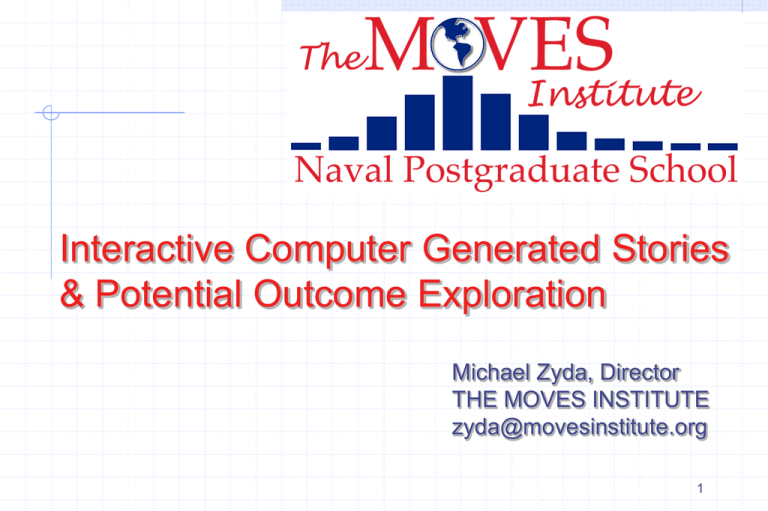
Interactive Computer Generated Stories & Potential Outcome Exploration Michael Zyda, Director THE MOVES INSTITUTE zyda@movesinstitute.org 1 Outline The MOVES Institute Research Program Directions in Computer Generated Autonomy Interactive Computer Generated Stories The Center for the Study of Potential Outcomes 2 The MOVES Institute Research Programs 3 MOVES Institute Mission Research, application and education in the grand challenges of modeling, virtual environments and simulation. 3D Visual Simulation Networked Virtual Environments Computer-Generated Autonomy Human Performance Engineering Technologies for Immersion Defense and Entertainment Collaboration Evolving Operational Modeling 4 Organizational Structure Director Michael Zyda Technical Directorate John Hiles - Computer-Generated Autonomy Don Brutzman - 3D Visual Simulation & Networked Virtual Environments Rudy Darken - Human Performance Engineering LCDR Russ Shilling, USN - Immersive Technologies Michael Capps - Defense & Entertainment Collaboration Alex Callahan - Evolving Operational Modeling 5 Collaborations Academic Boston College CalPoly Carnegie-Mellon University CSUMB Academic Old Dominion University, VMASC Queens University, Kingston, Ontario Non-Profit Fraunhofer Center for Research in Computer Graphics CNA ENIT, France UCB, Center for Design Visualization George Mason University UCF IST Institute for Defense Analysis Georgia Tech, MSREC UCSC MBARI INRIA University of Newcastle, Newcastle-upon-Tyne Monterey Bay National Marine Sanctuary University of Virginia Sea Grant Miami University MIT Lincoln Laboratories HPCC, Maui S. E. A. Lab Monterey Bay 6 Collaborations Corporate Bios Group Boeing Critical Mass Labs Dolby Emergent Designs Epic Games John Mason Associates Corporate Lucasfilm Skywalker Sound Lucasfilm THX MathEngine Microstrain MITRE Nexternet Potomac Institute Red Storm Entertainment Rolands & Associates SAIC Walt Disney Imagineering 7 Collaborations Navy CHSWP, Helicopter Wing Pacific Fleet Commander, Submarine Development Squadron TWELVE HS-8 - Helicopter AntiSubmarine Squadron EIGHT, FRS Navy Naval Research Laboratory, Electronic Warfare Group Naval Sea Systems Command, Advanced Systems & Technology Office Navy Toxicology Detachment, Wright Patterson Air Force Base Navy Modeling & Simulation Management Office, N6M Naval Undersea Warfare Center, Newport Naval Research Laboratory Marine Corps Combat Developments Center Marine Forces Pacific Training & Education Command Naval Submarine School HS-10 - Helicopter AntiSubmarine Squadron TEN, FRS Naval Oceanographic Office Marines NAWC-TSD Office of Naval Research Third Fleet 8 Collaborations OSD Army DARPA Army Research Office Defense Modeling & Simulation Office Assistant Sec. Army for Manpower & Reserve Affairs Defense Threat Reduction Agency J9 Office of the Director, Operational Test & Evaluation Office of Economic & Manpower Assessment Air Force Medical Command, San Antonio Other Los Alamos National Labs TRAC Monterey TRADOC USA OTC, Fort Hood Office of the Secretary of Defense OSD Program Analysis & Evaluation 9 Computer-Generated Autonomy Interactive Computer Generated Stories Center for the Study of Potential Outcomes 10 Interactive Computer Generated Stories Prof. John Hiles Jhiles@mindspring.com CDR Brian Osborn baosborn@nps.navy.mil 11 Modeling & Simulation - Linking Entertainment & Defense “… skilled storytelling techniques help participants in a virtual environment sense that they are in a real environment and behave accordingly.” Develop autonomous agent technology to carry out high level behavior of characters in a networked virtual environment Develop technology to guide those behaviors within the parameters of a given story line. 12 Motivation National Research Council Report Applications Scenario Based Training War Gaming Interactive Entertainment 13 Interactive Story Virtual World Believable Autonomous Characters Interactive User – Direct or indirect participant in the story…not an observer! Dynamic Storyline Dramatic Presentation Intensity Time 14 Believable Characters Adaptive & Innovative Procedural & Constrained Agent Behavior 15 Composite Agent Environment Agent (Actor) Sensed Input Symbolic Inner Environment SCA SCA SCA SCA SCA SCA Agent Actions RA RA RA RA RA 16 Tickets Constrain agent behavior when appropriate and provide a means for controlling events to promote the story. nonsequential sequential non-interruptible ! sequential sequential non-interruptible ! 17 Narrative Structure Allows the story to progress from it’s beginning, through the body of the story and finally to a climactic ending. Aristotle’s Poetics [Aristotle, 350 BC] Storytelling in the New Hollywood [Thompson, 1999] The Anatomy of a Screenplay [Siegel, 2001] Myth and the Movies [Voytilla, 1999] 18 Dynamic Storyline Storyline that adapts to the participant’s interaction and the state of the participant's character Bottom up approach Story elements combined at runtime to generate the story Scenes Interactions Characters 19 Scene: Smoking Main character is asked by a friend to sneak out of school for a cigarette. Characters: Jones (Main Character), buddy (student), Teacher, Principal Character traits of interest: Integrity Maturity Trustworthy Risk Management 20 Create a Character 21 View Characteristics 22 Scene: Smoking (Run Away) 23 Post-Scene Characteristics 24 So what’s the point? Create realistic, believable stories and scenarios from a knowledge base of story elements relevant to a given problem domain Capture tacit knowledge and project through meaningful training scenarios and stories An advanced technique coupling autonomous believable behavior with story-based control 25 Story Engine is for the Army Game Project 26 The Army Game Project We are building two intertwined game titles One 3D - using the Unreal Engine One 2D - similar to TheSims but with interactive story! 27 Army Game Project We are looking into how videogames can provide strategic communication about our client’s organization, the US Army. In addition, the games are instrumented to determine: Aptitude, leadership abilities & psychological profile. The games allow the exploration of potential career paths in an entertaining fashion … 28 A peek at the 3D game … 29 The Center for the Study of Potential Outcomes Michael Zyda, Director THE MOVES INSTITUTE zyda@movesinstitute.org 30 Some motivating video 31 Motivation for the Center Our society is built upon highly complex, interacting systems. Most of the time, people present at the systems don’t understand how they work, how they can fail, or what would happen if they did fail these are blind spots Attackers leverage precise answers to all three of these questions The Center’s job is to help us to see our most dangerous blind spots. 32 The Center Leverages Work at MOVES Novel Multi-Agent (MAS) simulation technology will be applied to the problem of anticipating unexpected actions and threats by organizations such as terrorist groups The Center leverages expertise and technology developed by the MOVES Institute at NPS The Center leverages institute expertise in terrorist behaviors. 33 MAS Research at MOVES (1) MOVES faculty have focused on a research goal of producing richer/faster adaptive models and simulations: models with richer and more complex behavior that can be produced in less time than were previously possible. 34 MAS Research at MOVES (2) MOVES is achieving this goal through the development of five technical innovations: A social and organizational relationship management engine (RELATE) A composite agent architecture An agent goal apparatus A structure for capturing and applying procedural knowledge within an agent (Tickets) An internal, contextual and temporal means of organizing the actions of agents (Connectors) 35 NPS MOVES MAS Technologies sequential non-interruptible nonsequential ! sequential non-interruptible sequential ! Environment Agent (Actor) Agent Actions Sensed Input Symbolic Inner Environment SCA SCA SCA SCA SCA SCA RA RA RA RA RA 36 MAS Research at MOVES (3) Other MOVES expertise combined with its MAS technology: Visual Simulation Human Performance Engineering High performance computing SMEs - terrorist behavior & asymmetric warfare 37 Technology for Potential Outcome Modeling High level MAS authoring tool usable by SMEs Auto-narrator package To provide SMEs an analysis without the requirement for understanding the underlying technology Movie Generator! 38 New Agent-based Engines Story Engine – Army Game Project, other training and communication jobs Scenario Engine – Exploring blind spots and unintended consequences Coupled with Movie Generator System 39 Story as the Human Interface Story or Scenario Engine Movie Generator System Model Output as a Movie 40 Templates Focus Scene Selection Story Engine Template Gives Narrative Structure… 41 New Templates for New Jobs Scenario Templates For Exploring Blind spots or Unintended Consequences 42 Story Engine Engine selects sequences of scenes based on some match of connectors. 43 Budget and Policy Decisions Budgets and policy decision place constraints on an organization. Model the succession of budgets or policies as if they were a story. Simulator can use different structures to reveal consequences. Strategy for scene selection STORY Introduction Complication Development Resolution Organization A crushes organization B Shaping Budgets (by A) Exploitation of vulnerabilities (by B) Rapid reorganization of resources (by A) A crushes B 44 Movie Generator Output! 45 Potential Applications for the Institute Technology There are many - these are just initial thoughts: Force protection Information Security Airport security Power Station Security Natural Gas Line Security Any domain where blind spots or terrorist vulnerabilities need to be explored. 46 In closing http://movesinstitute.org 47 Additional Details 48 Projects 49 3D Visual Simulation N6/ONR - Project VAST - Virtual At Sea Training Third Fleet - Tactical Information Visualization NUWC - Generic Hub: XML-Based Information Interchange for Defense Messaging, Shipboard/Theater Command & Control, and Distributed 3D BattleSpace Visualization MCCDC - Scenario Authoring and Visualization for Advanced Graphical Environments (SAVAGE): Amphibious Raid at Red Beach, Camp Pendleton California 50 Networked Virtual Environments N6 - NPSNET-V - An Architecture for Constructing Scalable, Dynamically Extensible, Networked Virtual Environments & Semantic Interoperability for Large-Scale, Networked Virtual Environments 51 Computer-Generated Autonomy ASA M&RA/N6 - Interactive Computer Generated Stories DMSO/DTRA/CDTEMS - Center for the Study of Potential Outcomes N6 - Analytical Decision-Support Using Synthesized AdaptiveAgent-Based and Mathematical Modeling 52 Human Performance Engineering ONR - Virtual Technologies & Environments - Navy & Marine Corp Expeditionary Warfare DARPA Augmented Cognition - The Context Machine: Determining Context from Symbolic Inputs 53 Technologies for Immersion N6 & ARO - Hybrid Inertial Motion Tracking for Inserting Humans into Networked Synthetic Environments ASA M&RA - Audio Engineering and Sound Design Issues in VE: Lessons Learned from the Entertainment Industry 54 Evolving Operational Modeling N6 - Synthetic Ocean Modeling N6 - Center for Operational Modeling - Navy Concepts, Research, & Analysis Network (NCRAN) N6 - Counterplanning in Simulation of Information Warfare 55 Defense & Entertainment Collaboration The MOVES Institute War Game Laboratory - A Videogame Research & Production Facility N6 - SimSecurity - A Distance Learning and Virtual Laboratory for Information Assurance ASA M&RA - Army Game Project 56
